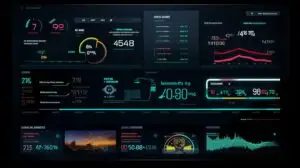Managing a Business Development Center (BDC) at your dealership can be challenging, and keeping track of its performance is even more so. But did you know that successfully running BDCs can significantly boost the profitability of dealerships? This article will guide you through the ins and outs of tracking BDC performance effectively to help you optimize productivity and improve customer satisfaction.
So, are you ready to supercharge your dealership’s success?
Key Takeaways
- Effectively tracking the performance of a Business Development Center (BDC) can significantly improve the profitability and customer satisfaction of dealerships.
- Key metrics for measuring BDC performance include contact rate, conversion rate, ROI evaluation, retention, revenue growth, and agent productivity.
- BDC Central offers tools like the BDC Tracker, BDC Mentor, call tracking and monitoring, and the Business Development Index (BDI)® to help dealerships track and optimize their BDC’s performance.
The Importance of BDC Performance Tracking
![]()
Keeping a close watch on the performance of a Business Development Center (BDC) is crucial, especially when dealing with issues like not enough training, a lack of accountability, and unclear expectations.
Tackling these problems is vital to ensure the BDC operates at its best, making a significant contribution to the overall success of the business.
By putting in place effective tracking methods, providing thorough training, and setting clear expectations, businesses can nurture a high-performing BDC that becomes a strategic asset in driving growth and achieving organizational goals.
Lack of training, accountability, and expectations

Many BDCs in the car trade do not grow well. This is because they do not get good training. They also lack firm rules and clear goals to reach for. To improve, these BDCs need to focus on key skills and tasks.
These include selling processes, workflows, templates, and CRM use. Daily checks by bosses are needed to make sure work duties are done right and well.
Metrics for measuring BDC performance

Checking how well a BDC works needs special tools. These are the metrics for measuring BDC performance:
- Contact rate: This shows how many customers you can reach. A high number is good.
- Conversion rate: It tells you how many leads turned into sales. The higher, the better.
- ROI evaluation: This figure shows the profit from your investment. When it’s large, the business is doing well.
- Retention: This tells you how many customers stay with you over time.
- Revenue growth: If this number goes up, it means more money is coming into the business.
- Agent productivity: It shows each agent’s work amount and quality.
Tracking agent productivity
![]()
Watching how well agents work is key in any business. Good BDC software helps with this task. It allows bosses to see how much work each agent does through calls, emails, and chats.
This way, no lead will get left out or forgotten. Knowing your team’s strengths and weaknesses can help make the whole group better. It helps ensure that everyone meets the goals of the dealership.
In turn, higher productivity leads to more sales and happy customers, which makes for a winning dealership!
BDC Central’s Solution for Performance Tracking
![]()
BDC Central offers a comprehensive solution for performance tracking, including the BDC Tracker, BDC Mentor, call tracking and monitoring, and the Business Development Index (BDI).
Explore the range of tools provided by BDC Central, a platform crafted to enhance your business operations.
Features like the BDC Tracker for performance analysis, the BDC Mentor for personalized guidance, call tracking and monitoring for improved communication oversight, and the Business Development Index (BDI) to assess and refine your business development strategies.
Uncover the capabilities within BDC Central, empowering your team with a comprehensive solution for optimizing performance and fostering strategic growth.
BDC Tracker
![]()
The BDC Tracker is a tool provided by BDC Central to help track and monitor performance in BDC dealerships. It allows dealership teams to develop their skills and be accountable for their work.
With the software, dealers can keep an eye on agent productivity and overall dealership performance. They can also use the tracked metrics to optimize schedules and manage resources more effectively.
By using the BDC Tracker, dealerships can improve their business development centers and increase future sales.
BDC Mentor

A BDC mentor is a key part of BDC Central’s solution for performance tracking in BDC dealerships. They offer guidance and support to dealership teams, helping them utilize the performance tracking tools effectively.
The BDC mentor is there to assist with team training, communication enhancement, and data analysis. With their help, the dealership can improve efficiency, optimize sales, and provide better customer service.
The mentor plays a crucial role in ensuring that the dealership gets the most out of the performance tracking software provided by BDC Central.
Call Tracking & Monitoring
![]()
BDC Central’s Call Tracking feature allows you to track and monitor all calls made by your team easily. With the “Call Log” display, you can quickly see an overview of every call made, including details like the date, time, and duration of each call.
This data is essential for analyzing your team’s performance and identifying areas for improvement. By utilizing call tracking analytics, you can increase your BDC’s efficiency and effectiveness in handling customer inquiries and requests.
Creating specific call tracking lines enables you to categorize incoming calls based on department and purpose, providing valuable insights into how different areas of your dealership are performing.
Business Development Index (BDI)
%C2%AE-079f829e3d-4164515031.jpg)
The Business Development Index (BDI) is a tool offered by BDC Central to track the performance of BDC teams in dealerships. It helps develop and hold these teams accountable for their work.
The BDI enables the tracking of basic and advanced metrics, including real-time evaluations of return on investment (ROI), customer retention, and revenue growth. With the BDI, dealerships can focus on engaging existing customers instead of constantly chasing new ones, which is crucial for success in today’s changing automotive market landscape.
Benefits of Effective BDC Performance Tracking
![]()
Effective BDC performance tracking leads to increased profitability, improved customer satisfaction, and optimal scheduling and resource management.
Increase profits and improve customer satisfaction with effective Business Development Center (BDC) performance tracking. Seamlessly integrate performance metrics into your operations to enhance financial outcomes and ensure a positive customer experience.
Efficiently manage scheduling and resources, utilizing insights from comprehensive performance tracking to coordinate and manage resources effectively. Take your BDC strategy to the next level by adopting a holistic performance tracking system that transcends metrics, creating a more profitable, customer-focused, and operationally efficient business environment.
Increased profitability

Effective BDC performance tracking can lead to increased profitability for BDC dealerships. By utilizing advanced CRM systems and tracking leads and customer relationships, dealerships can efficiently manage their sales process and maximize revenue.
With a well-functioning BDC team that is motivated, properly trained, and compensated based on performance, dealerships can enhance their financial success. The use of metrics beyond just sales figures and appointments can provide valuable insights into areas for improvement in order to optimize BDC performance and drive even greater profitability.
By implementing effective BDC performance tracking strategies, dealerships can achieve improved financial outcomes and ensure the success of their sales teams.
Improved customer satisfaction

Effective BDC performance tracking has a significant impact on improving customer satisfaction. When dealerships have a well-functioning Business Development Center (BDC), it contributes positively to overall customer satisfaction with their dealership experience.
By providing consistent and persistent follow-up, the BDC can increase be-backs (returning customers) and recapture declined service customers, leading to higher retention rates. This ultimately results in improved operational efficiencies and higher customer satisfaction index (CSI) ratings.
With effective BDC performance tracking, dealerships can ensure that they are meeting customer needs and delivering exceptional service throughout the entire customer journey.
Optimal scheduling and resource management

Effective BDC performance tracking leads to optimal scheduling and resource management at dealerships. By closely monitoring the metrics and key performance indicators (KPIs), dealerships can ensure that their resources, including staff and time, are utilized efficiently.
This helps in managing the workload effectively, improving productivity, and maximizing profitability. By analyzing data from performance tracking tools like BDC Tracker and Call Tracking and monitoring, dealerships can make informed decisions regarding staffing levels and training needs.
With optimal scheduling and resource management, dealerships can provide better customer service while also achieving their financial goals.
Insights and Best Practices for BDC Performance Tracking
![]()
Evaluate metrics beyond sales figures and appointments to get a comprehensive understanding of BDC performance, utilize data analysis for continuous improvement, and closely monitor key performance indicators (KPIs) for effective tracking.
When checking how well the Business Development Center (BDC) is doing, don’t just focus on sales and appointments. Take a broader look by using data analysis for insights to keep improving. Keep a close eye on key performance indicators (KPIs) for effective tracking and a complete understanding of how the BDC is working.
This method not only helps you understand performance better but also sets the stage for ongoing improvements and adjustments.
Evaluating metrics beyond sales figures and appointments

To effectively evaluate the performance of a BDC, it is important to look beyond just sales figures and the number of appointments. Here are some key metrics to consider:
- Percentage of inbound scheduled appointments: This metric measures how many of the incoming leads were successfully scheduled for appointments. It can help determine the BDC’s ability to handle customer inquiries effectively.
- Lead response time: The speed at which the BDC responds to customer inquiries is crucial in converting leads into sales. Monitoring the average response time can identify areas for improvement and ensure prompt customer service.
- Customer satisfaction ratings: Feedback from customers can provide valuable insights into the BDC’s performance. Tracking customer satisfaction ratings through surveys or reviews can help identify areas that need improvement and maintain high-quality service.
- Conversion rates: Tracking conversion rates can reveal how effective the BDC is at turning leads into actual sales. By analyzing this metric, dealership managers can identify training needs or process improvements to increase conversion rates.
- Upsell and cross-sell success: Evaluating the BDC’s ability to upsell or cross-sell additional products or services is important for maximizing revenue per sale. Monitoring this metric can highlight opportunities to improve sales strategies or refine product offerings.
- Customer retention rate: Keeping existing customers satisfied and engaged is crucial for long-term success. Monitoring customer retention rates can indicate how well the BDC is building strong relationships with customers and ensuring their continued loyalty.
Utilizing data analysis for improvement

Data analysis plays a crucial role in improving the performance of a dealership’s business development center (BDC). Here are some ways to utilize data analysis for improvement:
- Identify trends and patterns: By analyzing data, dealerships can uncover trends and patterns in customer behavior, market demand, and lead conversion rates. This information allows them to make informed decisions to improve their BDC’s effectiveness.
- Pinpoint areas for improvement: Data analysis helps identify specific areas where the BDC may be falling short. Whether it’s low appointment rates or slow response times, examining the data enables dealerships to focus on these problem areas and develop targeted strategies for improvement.
- Measure campaign success: By tracking key performance metrics, such as lead acquisition costs and conversion rates, dealerships can evaluate the success of their marketing campaigns. This data-driven approach allows them to allocate their marketing budget more effectively, maximizing the impact of their efforts.
- Enhance customer experience: Data analysis provides insights into customer preferences and behaviors. Dealerships can leverage this information to personalize interactions, tailor marketing messages, and provide a seamless customer experience throughout the buying journey.
- Optimize operational efficiency: By analyzing data related to appointment scheduling, agent productivity, and resource utilization, dealerships can optimize their operations. This includes streamlining processes, improving resource allocation, and ensuring that the BDC is operating at its highest efficiency level.
Monitoring key performance indicators (KPIs)
Monitoring key performance indicators (KPIs) is essential for tracking the success of a BDC. Here are some important ways to monitor KPIs:
- Analyzing data: By analyzing data such as lead conversion rates and customer satisfaction, BDCs can identify areas for improvement.
- Comparing to benchmarks: Monitoring KPIs allows BDCs to compare their performance to industry benchmarks, helping them understand how they stack up against the best in the business.
- Measuring progress: KPIs can be used as success metrics to track progress towards strategic goals. They provide a clear picture of whether the BDC is on track or needs adjustments.
- Identifying problems: When monitoring KPIs, any red flags or problems can be identified early on. This allows for timely intervention and improvement in performance.
- Driving accountability: Monitoring KPIs provides a way to hold employees accountable for their performance. It sets expectations and helps ensure that everyone is working towards the same goals.
Conclusion – BDC Dealerships Performance Tracking

Effective BDC performance tracking is crucial for the success of dealerships. By measuring metrics such as call response time, appointment show rates, and customer satisfaction scores, dealerships can optimize their productivity and profitability.
Investing in staff training and technology upgrades, regularly reviewing performance, and utilizing tools like BDC Central can help dealerships improve their overall performance and achieve success in the automotive industry.
FAQs
1. What is Bdc Dealerships Performance Tracking?
Bdc Dealerships Performance Tracking is a system or tool used to monitor and evaluate the performance of dealerships in terms of sales, customer satisfaction, and other key metrics.
2. How does Bdc Dealerships Performance Tracking work?
Bdc Dealerships Performance Tracking collects and analyzes data from various sources such as sales reports, customer feedback, and employee performance. It provides insights and metrics to help identify areas for improvement.
3. Why is Bdc Dealerships Performance Tracking important?
Bdc Dealerships Performance Tracking is important because it helps identify strengths and weaknesses in dealership operations. It enables managers to make informed decisions, improve efficiency, and enhance customer satisfaction.
4. Who can benefit from using Bdc Dealerships Performance Tracking?
Dealership owners, managers, and employees can benefit from using Bdc Dealerships Performance Tracking as it allows them to track their progress towards goals, identify areas needing improvement, and make data-driven decisions to drive success.
Alexi Walters stands out in the world of technology journalism as a pioneering female writer, bringing a fresh and insightful perspective to a field often dominated by male voices. Her passion for technology and its impact on society shines through in her compelling and thought-provoking articles.
Alexi’s journey in technology writing began soon after she graduated with a degree in Journalism, where she combined her love for storytelling with her fascination for tech innovations. Her ability to articulate complex technological concepts in a relatable and engaging manner quickly garnered her a dedicated readership.
Her work predominantly focuses on how technology can drive positive changes in various sectors, including education, healthcare, and environmental conservation. Alexi is particularly interested in the empowerment of women through technology, a theme that frequently appears in her writing.
As a female voice in technology writing, Alexi brings a unique perspective that challenges traditional narratives. She is known for her in-depth analyses of emerging trends, her critical examination of tech policies, and her interviews with leading figures in the tech world.
Alexi’s articles, which appear in several high-profile tech magazines and online platforms, are a blend of meticulous research and personal insight. They not only inform her readers but also inspire them to think critically about the role of technology in shaping our future.
Apart from writing, Alexi is an advocate for women’s representation in STEM fields. She frequently speaks at conferences and workshops, encouraging young women to pursue careers in technology. Her contributions have been recognized with several awards, further cementing her status as a leading voice in technology journalism.
Through her writing and activism, Alexi Walters continues to break barriers and inspire a new generation of female technology enthusiasts and professionals, making her a true trailblazer in her field.





